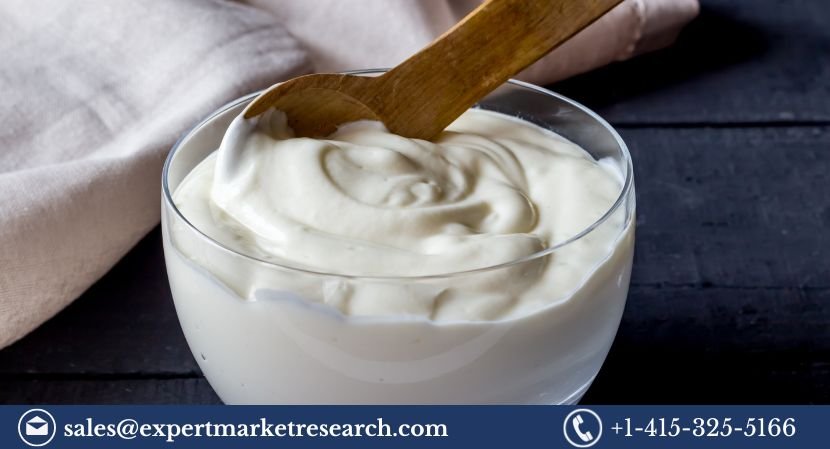The yoghurt market is witnessing significant momentum due to rising health consciousness and growing demand for convenient, nutrient-rich snacks. Yoghurt, a fermented dairy product, is consumed globally for its digestive benefits, high protein content, and versatility in flavors and forms. From breakfast options to dessert innovations, yoghurt appeals to a wide demographic, fueling both traditional and novel product launches. The growing trend toward functional foods and probiotics is amplifying the demand for yoghurt products. This aligns with consumers’ shifting focus toward gut health, weight management, and balanced nutrition, thereby contributing to robust market expansion.
Yoghurt Market Size
The yoghurt market was valued at approximately USD 54.92 billion in 2024, reflecting its robust presence in the global food and beverage industry. The market’s significant size is largely attributed to the rising awareness of yoghurt’s health benefits, including its role in digestive health, immune support, and as a high-protein snack. The expansion of product varieties—including traditional, Greek, and plant-based yoghurts—has played a critical role in reaching a diverse consumer base across multiple age groups and dietary preferences.
Yoghurt Market Set for Strong Growth: Insights from Expert Market Research
The yoghurt market, valued at nearly USD 54.92 billion in 2024, is poised for substantial growth with a projected CAGR of 6.00% through 2034, reaching USD 98.35 billion. Expert market research highlights that rising consumer awareness of health benefits, such as probiotics and high protein content, along with the surge in dairy-free and flavored options, are key drivers. Expanding distribution channels and product innovations are further fueling market expansion worldwide. This growth reflects shifting consumer preferences towards convenient, nutritious, and functional foods, making yoghurt a staple across diverse demographics globally.
Market Trends in the Yoghurt Industry
The global yoghurt market is witnessing transformative trends that are reshaping product development and consumer preferences. One of the most prominent trends is the growing popularity of health and wellness-oriented products, such as low-fat, high-protein, probiotic-rich yoghurts. With consumers becoming increasingly conscious about their gut health, immunity, and overall well-being, functional yoghurts fortified with vitamins, minerals, and live cultures are in high demand.
Another key trend is the surge in plant-based yoghurt alternatives, which cater to vegan, lactose-intolerant, and environmentally-conscious consumers. Made from almond, soy, coconut, and oat milk, these products are gaining shelf space in both physical and online stores. Moreover, flavored yoghurts—ranging from traditional fruit blends to exotic and dessert-inspired options—continue to attract younger consumers seeking indulgent yet healthy snack choices.
The market is also being influenced by convenient packaging innovations, such as squeezable tubes, on-the-go bottles, and resealable containers. These formats appeal to busy urban consumers and enhance portability. Technological advancements in cold chain logistics and longer shelf-life formulations are supporting broader distribution, especially in tropical and developing regions.
Market Opportunities and Challenges
Opportunities:
- Rising awareness about gut health and immunity-boosting properties of probiotic-rich yoghurts.
- Expansion in emerging markets such as Asia-Pacific and Latin America where yoghurt consumption is growing.
- Innovation in plant-based yoghurts, offering viable alternatives for lactose-intolerant and vegan consumers.
Challenges:
- Fluctuating dairy prices that affect the overall cost structure.
- Shelf-life concerns in certain regional markets with poor cold-chain infrastructure.
- High competition from alternative snacks and nutritional supplements.
Market Segmentation
Breakup by Category
- Conventional
- Dairy Free
Breakup by Type
- Set Yoghurt
- Greek Yoghurt
- Yoghurt Drink
- Frozen Yoghurt
- Others
Breakup by Flavour
- Flavoured
- Non-Flavoured
Breakup by Fat Content
- Regular
- Low Fat
Breakup by Packaging Type
- Cups
- Bottles
- Others
Breakup by Distribution Channel
- Supermarkets and Hypermarkets
- Convenience Stores
- Specialty Stores
- Online
- Others
Breakup by Regions
- North America
- Europe
- Asia Pacific
- Latin America
- Middle East and Africa
Yoghurt Market Growth Analysis
The yoghurt market is undergoing robust growth driven by a blend of health trends, product innovations, and consumer lifestyle shifts. As consumers prioritize nutrition, functional foods like yoghurt have gained prominence for offering probiotics, calcium, and high-quality protein. Yoghurt’s growing perception as a “superfood” has pushed it beyond a traditional breakfast item to a versatile component of snacks, smoothies, and meals.
This growth is particularly noticeable in Asia Pacific, where urbanization and rising middle-class income levels are expanding the consumer base. Government-led nutrition campaigns in countries like India and China are also promoting dairy consumption, further boosting yoghurt demand. Additionally, new market entrants and established players are investing heavily in R&D to introduce novel formulations, such as sugar-free, dairy-free, and fortified yoghurts.
Digital transformation in retail, especially the growth of e-commerce platforms, has allowed manufacturers to reach consumers directly, expanding their footprint and visibility. Subscription models and customized offerings have also helped enhance consumer engagement and loyalty.
Backed by these trends, the market is not only expanding in terms of volume but also evolving in sophistication. As highlighted by Expert Market Research, yoghurt brands are leveraging these dynamics to penetrate deeper into both urban and rural markets.
Yoghurt Market Forecast (2025–2034)
The yoghurt market is projected to witness consistent and substantial growth over the forecast period of 2025 to 2034, with an anticipated CAGR of 6.00%, reaching a market value of USD 98.35 billion by 2034. This promising forecast is fueled by several interlinked factors, including the ongoing global health movement, increased preference for functional foods, and rising awareness of gut health.
In addition, the expanding availability of dairy-free and organic yoghurt products is attracting niche consumer groups who seek clean-label and plant-based alternatives. Manufacturers are also responding to sustainability trends by offering eco-friendly packaging and sourcing locally produced ingredients, aligning their practices with environmental and ethical concerns.
Emerging markets are expected to contribute significantly to the forecasted growth. Rapid economic development, population growth, and a growing middle-class consumer base in countries such as China, India, Brazil, and Indonesia are generating new avenues for yoghurt manufacturers.
Retail infrastructure improvements, combined with enhanced cold chain distribution, are making it easier for yoghurt to reach remote areas, increasing penetration in untapped regions. According to Expert Market Research, companies that prioritize innovation, affordability, and sustainability will be best positioned to capitalize on the evolving market dynamics over the coming decade.
Competitor Analysis
The yoghurt market is characterized by intense competition among global and regional players striving to differentiate through innovation, taste, and nutrition. Companies are increasingly focusing on R&D to introduce low-fat, high-protein, and dairy-free options to meet varying consumer preferences. Strategic collaborations, acquisitions, and expansions are key tactics employed to gain market share.
Nestlé S.A.: Leading multinational offering wide product variety in dairy and plant-based yoghurt lines.
Danone S.A.: Known for innovations in probiotic and health-focused yoghurt products.
Lactalis American Group, Inc.: A strong portfolio across multiple yoghurt categories and distribution networks.
Royal FrieslandCampina NV: Offers premium and functional yoghurts with strong presence in Europe and Asia.
China Mengniu Dairy Company Limited: Leading Chinese firm with diversified yoghurt product lines.
Fonterra Co-operative Group Limited: Focuses on protein-rich and functional yoghurt innovations.
General Mills Inc.: Popular for brands like Yoplait and extensive distribution in North America.
Others: Includes regional and niche players contributing to category-specific innovation.
Media Contact:
Company Name: Claight Corporation
Contact Person: Emily Jacks, Business Consultant
Email: sales@expertmarketresearch.com
Toll Free Number: US +1-415-325-5166 | UK +44-702-402-5790
Address: 30 North Gould Street, Sheridan, WY 82801, USA
Website: www.expertmarketresearch.com


